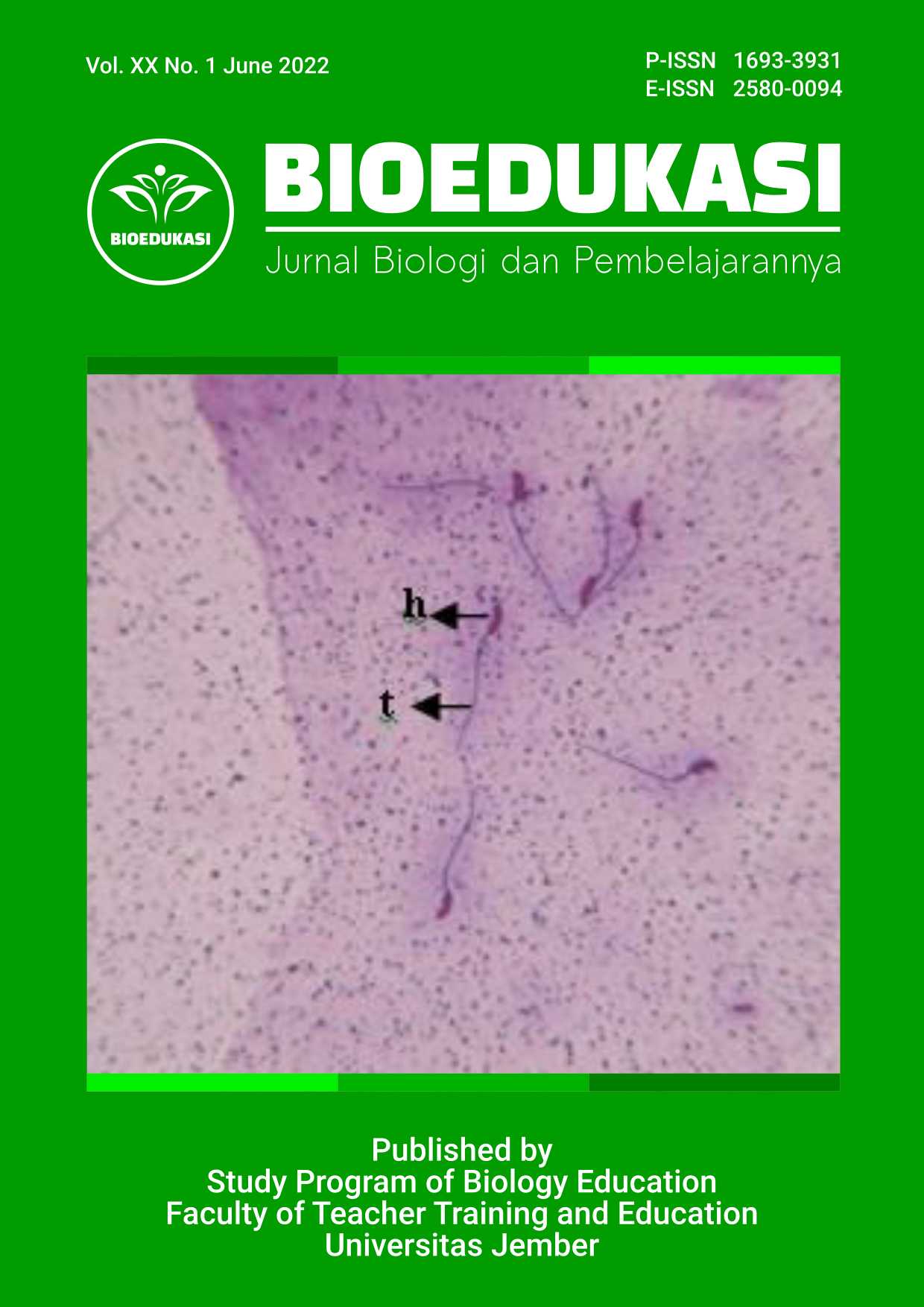USING sma-its2 PRIMER FOR ITS2 (Internal Transcribed Spacer-2)-BASED MOLECULAR CHARACTERIZATION OF Anopheles minimus FROM KULONPROGO, YOGYAKARTA - INDONESIA
DOI:
https://doi.org/10.19184/bioedu.v20i1.31911Keywords:
Anopheles, ITS2, Malaria, sma-its2, VectorAbstract
Malaria is a public health threat caused by the Plasmodium infection transmitted by the Anopheles mosquito. Malaria vector control is highly dependent on the ability to determine mosquito species' vectorial and bionomic capacity. Species identification based on morphological characteristics as well as DNA-barcoding approaches is a very important step in determining vectorial capacity. Our research group has redesigned a new ITS2 primer, namely, sma-its2, which is specifically able to identify the Anopheles (An.) mosquito vector but cannot identify other mosquito vectors. This study wanted to test this primer's specificity further for identification of other Anopheles mosquitoes. We used An. minimus collected from Kulonprogo, Yogyakarta – Indonesia. The methods used in this research are as follows: landing collection, morphological identification, isolation of genomic DNA, PCR (Polymerase Chain Reaction), PCR product purification, sequencing, and data analysis. An. vagus from Bangsring, Banyuwangi – Indonesia, which had previously been identified using the same primary, was used as a positive control. The results of the morphological analysis showed that both species were in accordance with the vector identification key used in this study. The molecular analysis showed that the sma-its2 primer could amplify the ITS2 sequence of An. vagus and An. minimus, producing 650 – 700 bp. However, further analysis of the ITS2 sequences of both species, resulted in the same species, namely An. vagus, with a different accession number in GenBank. This showed that the sma-its2 primar can be used to identify An. vagus but cannot be used to identify An. minimus. Analysis of the primer position in the ITS2 sequences showed the presence of 3 nucleotides in the forward sma-its2 primer that was not recognized by the An. minimus sequences and thus, hinder the successful identification of these species.
Downloads
References
Batovska, J., Cogan, N. O. I., Lynch, S. E., & Blacket, M. J. (2017). Using next-generation sequencing for DNA barcoding: Capturing allelic variation in ITS2. G3: Genes, Genomes, Genetics, 7(1), 19–29. https://doi.org/10.1534/g3.116.036145
Dai, J. Y., Sun, Y. Q., & Xiu, Z. L. (2014). Separation of bio-based chemicals from fermentation broths by salting-out extraction. Engineering in Life Sciences, 14(2), 108–117. https://doi.org/10.1002/elsc.201200210
Dritsou, V., Deligianni, E., Dialynas, E., Allen, J., Poulakakis, N., Louis, C., Lawson, D., & Topalis, P. (2014). Non-coding RNA gene families in the genomes of anopheline mosquitoes. BMC Genomics, 15(1). https://doi.org/10.1186/1471-2164-15-1038
Fathiya, N., Harnelly, E., Thomy, Z., & Iqbar. (2018). Molecular identification of Shorea johorensis in Ketambe research station, gunung Leuser national park. Jurnal Natural, 18(2), 56–64. https://doi.org/10.24815/jn.v0i0.7032
Filali, O. B., Kabine, M., El Hamouchi, A., Lemrani, M., Debboun, M., & Sarih, M. (2018). First Molecular Identification and Phylogeny of Moroccan Anopheles sergentii (Diptera: Culicidae) Based on Second Internal Transcribed Spencer (ITS2) and Cytochrome c Oxidase i (COI) Sequences. Vector-Borne and Zoonotic Diseases, 18(9), 479–484. https://doi.org/10.1089/vbz.2018.2269
Jannah, M., & Rahayu, D. A. (2019). Dna Barcode Hewan Dan Tumbuhan Indonesia. Inside.
Luca, M., Toma, L., Boccolini, D., Severini, F., La Rosa, G., Minelli, G., Bongiorno, G., Montarsi, F., Arnoldi, D., Capelli, G., Rizzoli, A., & Romi, R. (2016). Ecological distribution and CQ11 genetic structure of Culex pipiens complex (Diptera: Culicidae) in Italy. PLoS ONE, 11(1), 1–16. https://doi.org/10.1371/journal.pone.0146476
Munawar, K., Saleh, A., Afzal, M., Qasim, M., Khan, K. A., Zafar, M. I., & Khater, E. I. (2020). Molecular characterization and phylogenetic analysis of anopheline (Anophelinae: Culicidae) mosquitoes of the Oriental and Afrotropical Zoogeographic zones in Saudi Arabia. Acta Tropica, 207(June). https://doi.org/10.1016/j.actatropica.2020.105494
O’connor, C. T., & Soepanto, A. (2013). Kunci bergambar nyamuk Anopheles dewasa di Indonesia dan bergambar jentik Anopheles di Indonesia.
Reid, J. A. (1968). Anopheline Mosquitoes of Malaya and Borneo. In Goverment of Malaysia (Issue 31). https://doi.org/10.1093/jmedent/3.3-4.327
Rubio, A. L., Suaza-Vasco, J., Marcet, P. L., RuÃz-Molina, N., Cáceres, L., Porter, C., & Uribe, S. (2016). Use of DNA barcoding to distinguish the malaria vector Anopheles neivai in Colombia. Zootaxa, 4175(4), 377–389. https://doi.org/10.11646/zootaxa.4175.4.7
Sawabe, K., Imanishi-Kobayashi, N., Maekawa, Y., Higa, Y., Kim, K. S., Hoshino, K., Tsuda, Y., Hayashi, T., Nihei, N., Takai, K., Kurihara, T., & Kobayashi, M. (2021). Updated distribution of anopheline mosquitoes in Hokkaido, Japan, and the first evidence of Anopheles belenrae in Japan. Parasites and Vectors, 14(1), 1–19. https://doi.org/10.1186/s13071-021-04995-w
Senjarini, K., Abdullah, M. K., Azizah, N., Septianasari, M. A., Tosin, A., Oktarianti, R., Wathon, S., & Raras, T. M. (2021). Redesigning Primer of ITS2 ( Internal Transcribed Spacer 2 ) for Specific Molecular Characterization of Malaria Vectors Anopheles Species. Med Arch., 75(6), 418–423. https://doi.org/10.5455/medarh.2021.75.418-423
Senjarini, K., Hasanah, L. N. U. H., Septianasari, M. A., Abdullah, M. K., Oktarianti, R., & Wathon, S. (2021). Karakterisasi berbasis marka molekuler ITS2 terhadap sub-spesies kompleks Anopheles vagus vagus dan Anopheles vagus limosus. Jurnal Bioteknologi Dan Biosains Indonesia, 8(2), 174–184. https://doi.org/10.29122/jbbi.v8i2.4737
Setiyaningsih, R., Trapsilowati, W., Mujiyono, M., & Lasmiati, L. (2018). Pengendalian Vektor Malaria di Daerah Endemis Kabupaten Purworejo, Indonesia. Balaba: Jurnal Litbang Pengendalian Penyakit Bersumber Binatang Banjarnegara, 1–12. https://doi.org/10.22435/blb.v14i1.290
Soltanbeiglu, S., Vahedi, M., Mohammadi Bavani, M., & Chavshin, A. R. (2020). Molecular Characterisation of Cytochrome Oxidase I and Internal Transcribed Spacer 2 Fragments of Culiseta longiareolata. Turkiye Parazitolojii Dergisi, 44(4), 191–196. https://doi.org/10.4274/tpd.galenos.2020.6886
Suwannamit, S. (2021). Identification of Five Sibling Species of the Anopheles barbirostris complex (Diptera : Culicidae) in Thailand by a Polymerase Chain Reaction Assay. Science and Technology, 3(29), 1–8.
Syafruddin, D., Lestari, Y. E., Permana, D. H., Asih, P. B. S., Laurent, B. S., Zubaidah, S., Rozi, I. E., Kosasih, S., Shinta, Sukowati, S., Hakim, L., Haryanto, E., Mangunwardoyo, W., Bangs, M. J., & Lobo, N. F. (2020). Anopheles sundaicus complex and the presence of anopheles epiroticus in Indonesia. PLoS Neglected Tropical Diseases, 14(7), 1–16. https://doi.org/10.1371/journal.pntd.0008385
Wages, J. . (2020). Polymerase chain reaction. Handbook of Clinical Neurology, 123(1), 45–66.
Wang, X. T., Zhang, Y. J., Qiao, L., & Chen, B. (2019). Comparative analyses of simple sequence repeats (SSRs) in 23 mosquito species genomes: Identification, characterization and distribution (Diptera: Culicidae). Insect Science, 26(4), 607–619. https://doi.org/10.1111/1744-7917.12577
Zomuanpuii, R., Ringngheti, L., Brindha, S., Gurusubramanian, G., & Senthil Kumar, N. (2013). ITS2 characterization and Anopheles species identification of the subgenus Cellia. Acta Tropica, 125(3), 309–319. https://doi.org/10.1016/j.actatropica.2012.12.001






